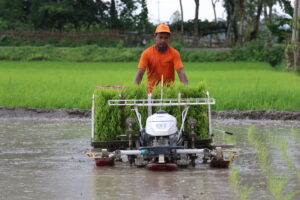by Kei Kajisa, Piedad Moya, and Fe Gascon
The Central Luzon Loop Survey in the Philippines (the Loop Survey) is one of the longest-running and still ongoing household-level farm surveys in tropical Asia. The survey has been conducted every four to five years until 2021 covering a period of more than half a century. This discussion includes the impact of the COVID-19 pandemic on rice farming. The Loop Survey can provide important information for this purpose and contribute to drawing useful lessons for Asian countries and show possible future paths for rice-producing Sub-Saharan African countries.
The Central Luzon Loop Survey in the Philippines (the Loop Survey) is one of the longest-running and still ongoing household-level farm surveys in tropical Asia. The International Rice Research Institute started the survey on the eve of the Green Revolution in 1966, the year of the official release of the miracle rice, IR8. Since then, the survey has been conducted every four to five years until 2021, generating 14 rounds of datasets, covering a period of more than half a century.
The datasets of this feature enable us to explore the situation of rice farming and rice farm families before the Green Revolution, how the situation changed through the progress of the Green Revolution, and the emerging issues in the post-Green Revolution era in the Philippines.
The Loop Survey revealed Green Revolution’s substantial impact on the country’s food production and poverty alleviation. Among the 34 major publications (books, reports, and journal articles) produced from the Loop Survey, comprehensive documentation from 1966 (first round) to 2012 (12th round) was found in a study by Moya et al. (2015).
It shows that the paddy (unmilled rice) yield per hectare had increased from 2.3 tons per hectare (t/ha) in 1966 to 3.9 t/ha in 2011 in the wet (rainy) season and from 1.8 t/ha in 1967 to 5.8 t/ha in 2012 in the dry season, thereby increasing the farmers’ rice income. Accordingly, the first-generation Green Revolution farmers increased schooling investment in their children, resulting in an increase in the proportion of secondary- or tertiary-level graduates from 18 to 65% in the same period.
These educated children moved to the non-agricultural sector. Hence, although the proportion of rice income increased from 68% in the 1960s to 86% in the 1970s, it decreased successively since then to the level of 17% in the first decade of the twenty-first century (‘00s), whereas the proportion of off-farm income and remittances accounted for 34% and 28%, respectively. In general, countries benefiting from the Green Revolution show a similar pattern of agricultural development and income change.
However, Green Revolution-style agricultural development is now at a crossroads. It is ironic that the Green Revolution, which has achieved success through the advancement of seed-fertilizer technology and the adoption of labor-intensive crop care, is now challenged by increasing rural labor scarcity caused by its success.
This is an inevitable historical pattern of agricultural transformation in the Philippines and other countries that have started economic ‘take-offs’. Furthermore, disasters and infectious disease pandemics are becoming increasingly rampant as contemporary phenomena. The achievement of sustainable rice farming is challenged by these contemporary issues.
This chapter aims to identify emerging issues in rice farming in the post-Green Revolution era in the Philippines using the last two rounds of the Loop Survey, namely the 2015–16 and 2020–21 rounds. This discussion includes the impact of the COVID-19 pandemic on rice farming.
Rice farming in Central Luzon is at a crossroads. Rice yields have stagnated and have become more variable in the last decade, despite a prompt and continuous switch to newer varieties. To choose the right direction moving forward from the crossroads, we need further studies to make rice farming more resilient to rapid demographic changes, rampant disasters, and future pandemics.
The Loop Survey can provide important information for this purpose and contribute to drawing useful lessons for Asian countries and show possible future paths for rice-producing Sub-Saharan African countries.
Read the study:
Kajisa, K., Moya, P., Gascon, F. (2023). The Central Luzon Loop Survey: Rice Farming in the Philippines from 1966 to 2021. In: Estudillo, J.P., Kijima, Y., Sonobe, T. (eds) Agricultural Development in Asia and Africa. Emerging-Economy State and International Policy Studies. Springer, Singapore.






Industrialization must now be DRASTICALLY applied to agriculture in the Philippines. It should be a public goal that each rice farmer gets to own a fully *automatic* rice transplanter. DOST may be able to produce some as public property or as grantable items through mechanical engineers, since it would mostly be diesel engine and arm assembly made of steel. It presumably uses less fuel than any typical car we see on the road, much less than a truck. The nearly 100,000-peso price tag from private manufacturers esp those from foreign countries is almost unjustifiable, and is mostly dependent on the price of steel used besides the markup, so DOST has got an opportunity here. The diesel engine, if DOST chooses to buy it instead of make it, may be around 20,000 pesos with the markup, while the rest are in a way similar to bike assembly and are already implemented in manual transplanters; the diesel engine may alternatively be incorporated into existing manual transplanters (which also have markup), albeit inconvenient for use and may be hazardous. More rows from these transplanters may also increase efficiency.